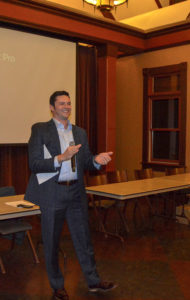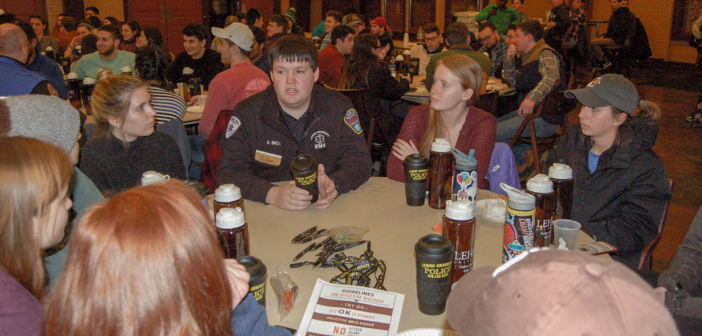Student Senate hosted “Convos with a Cop” an event Wednesday evening that enabled students to ask questions and voice concerns to Bethlehem and Lehigh University police department officers.
Group discussions were held at separate tables, each with about five or six students, at least one police officer and an EMT.
LUPD Police Chief Jason Schiffer, who was hired in January following the retirement of Chief Edward Shupp, spoke about his experience as BPD police chief from 2011 to 2013. He also addressed the lack of respect he received from students hosting or attending off campus parties.

New Lehigh University Police Chief Jason D. Schiffer leads an icebreaker with the audience for ‘Convos with a Cop’ on Wednesday at Lamberton Hall. Schiffer was recently named the Police Chief of LUPD. (Kendall Coughlin/B&W Staff)
“I, as well as my fellow officers, are aware of the parties that occur at Lehigh and we’re not strict in terms of always shutting them down,” Schiffer said. “However, it is when they get too out of hand and result in the hospitalization of students and the destruction of public property that we must intervene.”
Steve Lewis, an EMT and the staff adviser for Lehigh’s Emergency Medical Services, spoke about the actions he takes to keep students safe.
“The biggest fear for all EMTs is to not be diligent enough in assessing a person’s state of being,” Lewis said. “A person could appear to be inebriated, but instead it could be a bigger underlying problem occurring, such as a head injury. In this job, we must be extremely thorough to not write off someone as just another drunk when it could be something else causing them to act that way.”
Later in the evening, each table planned an imaginary party, deciding on details such as how many people would be in attendance, whether alcohol would be present and what kind of alcohol would be served.
Students and officers discussed how to responsibly handle the situation and thought of ways to ensure the safety of everyone in attendance. After 20 minutes, a student representative from each group explained the group’s plan to the room and the group’s police officer reflected on how she or he felt the students handled the situation.
“It was a little uncomfortable at first to be planning out a party with a police officer and an EMT giving their input beside you,” Sophia Closter, ’21, said, “but they were both very understanding and offered insight from their experiences that I found very useful and important.”
Christopher Mulvihill, the associate dean of students, spoke about Lehigh’s medical amnesty policy. He said students often misunderstand the policy, and explained how it works and who is covered by the policy in certain situations.
“The most important thing that students must understand is that they are not going to get in trouble if they call for help for themselves or for another person,” Mulvihill said. “We aren’t trying to penalize people for doing the right thing.”
Officials also shared medical statistics from the fall 2017 semester. Over the course of the semester, there were 64 alcohol-related hospitalizations, and the average blood alcohol level of cited students was .245 percent. The highest blood alcohol level recorded for the semester was .545 percent.
“With a blood alcohol level of .3 percent being the level at which death becomes a possibility, the person with the .545 percent should not have lived and is very lucky to be alive,” Closter said. “It is really scary to think about how that level of drinking goes on at this campus, which is why it is so important to have events like these that hopefully prevent people from making bad decisions like that.”
Student Senate president Matt Rothberg, ’18, said he thinks the event was the first step in fixing a large cultural issue on Lehigh’s campus.
LUPD Sgt. David Kokinda said he thinks the relationship between students and officers should change.
“What we’d like to see is the students be more interactive with us and not be afraid to talk to us,” Kokinda said. “There would be many instances when I’d be walking down East Fifth Street at night during the weekend and students would cross the street trying to avoid me. Always say ‘hi’ to us and don’t run away from us. Once that happens, this bridge between students and the police should be dissolved.”






Comment policy
Comments posted to The Brown and White website are reviewed by a moderator before being approved. Incendiary speech or harassing language, including comments targeted at individuals, may be deemed unacceptable and not published. Spam and other soliciting will also be declined.
The Brown and White also reserves the right to not publish entirely anonymous comments.
2 Comments
“Officials also shared medical statistics from the fall 2017 semester. Over the course of the semester, there were 64 alcohol-related hospitalizations, and the average blood alcohol level of cited students was .245 percent. The highest blood alcohol level recorded for the semester was .545 percent.”
Truly scary.
Yet, even in the face of these statistics, the undergrads decry “heavy handed” policing as abusive and claim that, if only they were given more leeway, there wouldn’t be such excessive drinking. Yeah ok.